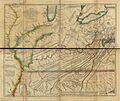Samuel Stalnaker facts for kids
Quick facts for kids
Samuel Stalnaker
|
|
|---|---|
| Born |
Samuel Stalnaker
1715 Westphalia, Germany
|
| Died | 1769 (aged 53–54) |
| Occupation | Guide, Indian trader, tavern owner/proprietor |
| Known for | Escaping from captivity among the Shawnees, then journeyed 460 miles to warn of imminent attacks on English settlements; Among the first Europeans to cross the Cumberland Gap |
| Spouse(s) | Susanna (d. 18 June, 1755); Margaret |
| Children | 5 |
Samuel Stalnaker (born around 1715 – died 1769) was an important explorer, guide, and one of the first settlers in the western part of Virginia. He opened a tavern in 1752 near what is now Chilhowie, Virginia. Samuel was captured by Shawnee Indians in Kentucky and held for almost a year. After a brave escape, he traveled over 460 miles to Williamsburg, Virginia. He went there to warn everyone about French plans to attack English settlements. Later, he even worked as a guide for George Washington during the French and Indian War.
Contents
Samuel's Early Life and Moving to Virginia
Samuel Stalnaker was likely born around 1715. He came from a region in Germany called the Palatinate or Westphalia. Some records suggest he arrived in Virginia as early as 1732. By 1745, Samuel was living on the New River in southwestern Virginia. This area was the edge of the frontier, mostly settled by Scots-Irish and German immigrants.
In October 1745, Samuel bought land near what is now Radford, Virginia. He paid £3 for 100 acres. He and his wife, Susanna, had a daughter named Maria Barbara in 1743.
Exploring the Frontier and Meeting Dr. Walker
In 1748, explorer Dr. Thomas Walker met Samuel Stalnaker. Samuel was on his way to visit the Cherokees, working as a trader. He was already very experienced in trading and hunting. In November 1749, Samuel and Susanna had a son, also named Samuel. They then moved even further west to the Holston River, near present-day Chilhowie, Virginia. This area was known as "Indian Fields."
On March 23, 1750, Dr. Walker and his group met Stalnaker again. They helped him build a cabin on the Holston River. At that time, Samuel Stalnaker was the westernmost English settler in Virginia. His trading route to the Cherokees went through a mountain pass. Dr. Walker later named this pass the Cumberland Gap.
Becoming a Captain and Opening a Tavern
In May 1750, Samuel helped build a new road. This road connected different settlements and brought more people and trade to the area. Seeing this growth, Samuel decided to open a tavern.
On November 21, 1752, Samuel became a captain in the Virginia militia. The militia was a group of citizen soldiers. At this time, the famous George Washington was also a major in the militia.
Samuel Stalnaker's Tavern: A Frontier Hub
On November 7, 1752, Samuel got a license to run a tavern. He promised to provide good food, clean lodging for travelers, and care for their horses. He also promised not to allow any illegal gambling or excessive drinking.
By 1753, many Cherokees were camping near Samuel's trading post. They came to trade, and Samuel provided them with supplies. Samuel's tavern became known as "The Town House." It was a very important meeting place on the frontier.
In 1756, Native American leaders wanted to hold a treaty meeting at Stalnaker's tavern. However, the location was changed because Samuel had been captured by Native Americans, and people thought he was dead. The tavern later became a stagecoach stop called Chillhowie Springs.
Samuel's Capture and Daring Escape
On June 18, 1755, Shawnee warriors attacked Samuel Stalnaker’s settlement. They captured Samuel, his wife, and his son Adam. They also captured two other men. Sadly, Samuel's wife and son Adam, along with the others, were killed. Samuel's mother and four other children were hiding nearby and managed to escape.
Samuel and another captive, Samuel Hydon, were taken by the Shawnee to "Lower Shawneetown" on the Ohio River. This was a long journey. People in Virginia thought Samuel was dead. His colonel even started the process to manage his estate.
News of His Survival and Escape
In August 1755, another captive named Mary Draper Ingles met Samuel Stalnaker in Lower Shawneetown. She reported that he was still alive and well.
On May 10, 1756, Samuel Stalnaker made a daring escape. He traveled for 40 days, covering over 460 miles. He reached Williamsburg, Virginia, to report to Governor Robert Dinwiddie. Samuel warned the governor about a planned attack by the French and Native Americans on English settlements. This information was very important for the safety of the frontier.
On July 29, 1756, Samuel attended a war council. He suggested building forts to protect the settlements.
Samuel's Military Service and Later Years
Governor Dinwiddie wanted to promote Samuel Stalnaker to lieutenant. He believed Samuel would be very helpful because he knew the woods well and was a good guide. By 1758, Samuel was working as a guide for British troops.
Samuel remarried sometime around 1761 to a woman named Margaret. He continued to run his tavern. In 1761, Colonel William Byrd and his troops stayed at Stalnaker's tavern during the Anglo-Cherokee War. They built a small fort nearby.
Samuel Stalnaker was last seen in May 1769. An English traveler visited him at his old log cabin on the Holston River. Samuel, still a wise pioneer, described a new, shorter route into Kentucky. Samuel Stalnaker does not appear in records after this visit, so 1769 is believed to be the year he died.
Samuel's Family
Samuel Stalnaker is thought to have had three brothers: George, Jacob, and Adam. He had five children: Jacob (born 1737), Adam (born 1738), Maria Barbara (born 1743), Samuel (born 1749), and George Christian (born 1752). His first wife, Susanna, and his son Adam were killed during the Shawnee attack in 1755. He later married Margaret around 1761.
Images for kids



